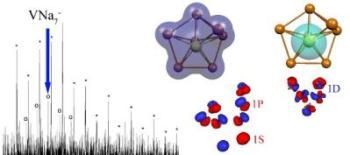Apr 2 2013
Sounding like something out of a comic book, superatoms are not only an enticing idea, but experiments have confirmed they exist. Scientists at Virginia Commonwealth University have collaborated with scientists from Johns Hopkins University to synthesize the first magnetic superatoms.
 On the left, the mass spectra of clusters show the existence of the Na7V- superatoms. The middle graphical representation details the geometrical structure and the electronic orbitals in the cluster with the far right showing the D-orbitals that breed the magnetic character. Image provided by Shiv Khanna, Ph.D.
On the left, the mass spectra of clusters show the existence of the Na7V- superatoms. The middle graphical representation details the geometrical structure and the electronic orbitals in the cluster with the far right showing the D-orbitals that breed the magnetic character. Image provided by Shiv Khanna, Ph.D.
The existence of magnetic superatoms was previously predicted by the group at VCU and collaborators in a paper appearing in Nature Chemistry. The current work now shows that superatoms can be synthesized.
Superatoms are small clusters of atoms that can imitate various elements in the periodic table. They are the potential building blocks for nanostructured materials that one day may be used to create molecular electronic devices for the next generation of faster computers with larger memory storage.
“The work at VCU has also shown that assemblies of such magnetic species could lead to novel electronic systems with potential applications in spintronics, an area where new devices for memory and data processing using electron spin can be synthesized,” said Shiv N. Khanna, Ph.D., Commonwealth professor in the Department of Physics, part of the VCU College of Humanities and Sciences. “The creation of such magnetic species opens the pathway to these and other applications.”
The experimental synthesis involved ionization of sodium and vanadium to synthesize bimetallic species. The theoretical prediction had identified Na8V as a superatomic species with a magnetic moment of five Bohr magnetons. The studies conducted by the experimental group at Johns Hopkins led by Kit Hansell Bowen Jr., E. Emmet Reid Professor in the departments of Chemistry and Materials Science, focused on anionic species Na7V- or Na8V clusters.
According to Khanna, the measurement of the magnetic moment of such small species is difficult, hence the Johns Hopkins group used an indirect approach proposed by the scientists at VCU. The approach involves the combination of the theoretical work with experimental negative ion photodetachment spectrum. The results confirmed the theoretical prediction that the resulting species is indeed magnetic. These results were reported in the Journal of the American Chemical Society.
“This work is significant. It is a pretty important finding as it opens the pathway to potential applications,” Khanna said.
“It also highlights the importance of the original work done by our team at VCU,” said Jose Reveles Ramirez, Ph.D., a co-author in the group at VCU.